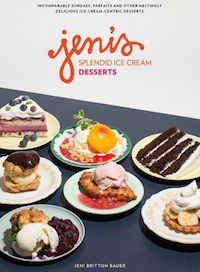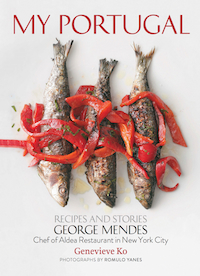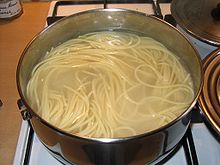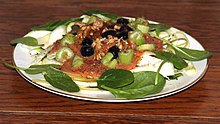his article is about the preparation of food. For a general outline, see food preparation. For varied styles of international food, see cuisine.
A US Navy Cook preparing steak
Preparing food with heat or fire is an activity unique to humans. Some anthropologists think that cooking fires first developed around 250,000 years ago, although there is evidence for the controlled use of fire by Homo erectus beginning 400,000 years ago.[1][2]
The expansion of agriculture, commerce, trade and transportation between civilizations in different regions offered cooks many new ingredients. New inventions and technologies, such as the invention of pottery for holding and boiling water, expanded cooking techniques. Some modern cooks apply advanced scientific techniques to food preparation to further enhance the flavor of the dish served.[3]
Water
Main article: Water
Water is often used to cook foods such as noodles.
Effects on nutritional content of food
See also: Raw foodism
Proponents of raw foodism argue that cooking food increases the risk of some of the detrimental effects on food or health. They point out that during cooking of vegetables and fruit containing vitamin C, the vitamin elutes into the cooking water and becomes degraded through oxidation. Peeling vegetables can also substantially reduce the vitamin C content, especially in the case of potatoes where most vitamin C is in the skin.[20] However, research has shown that in the specific case of carotenoids a greater proportion is absorbed from cooked vegetables than from raw vegetables.[13]German research in 2003 showed significant benefits in reducing breast cancer risk when large amounts of raw vegetable matter are included in the diet. The authors attribute some of this effect to heat-labile phytonutrients.[21] Sulforaphane, a glucosinolate breakdown product, which may be found in vegetables such as broccoli, has been shown to be protective against prostate cancer, however, much of it is destroyed when the vegetable is boiled.[22][23]
Sandwich of Justice - You Suck at Cooking
1 Plenty More Yotam Ottolenghi
(Ebury, £27; click here to buy it from Guardian Bookshop for £17)
Like 2010’s global best-seller Plenty, a reminder that vegetable-based dishes can be creative and imaginative as well as delicious. Try the brilliant savoury cauliflower cake.
2 Fish and Shellfish Rick Stein
(BBC Books, £25: click here to buy it for £20)
Updated version of his classic Seafood. The step-by-step tips are ideal for beginners keen to start prepping crustaceans or making velouté, the 120 dishes a brilliant selection from his travels.
3 The Oxford Companion to Food: Alan Davidson, ed. Tom Jaine
(Oxford University Press, £40; click here to buy it for £32)
Now in its third edition with 43 new entries including (of course) foraging, convenience foods and obesity, Alan Davidson’s great life work is lovingly maintained by its faithful editor Tom Jaine. Open any page and luxuriate in Davidson’s wisdom and wit.
BIRYANI (HOW TO COOK PERFECT
BIRYANI Pakistani and Indian Cooking

The New Charcuterie Cookbook: Exceptional Cured Meats to Make and Serve at Home
Jamie BissonnettePage Street
Beard Award winning chef Jamie Bissonnette has written a charcuterie book for a new generation. The classics are here: salumi, pates, etc. But Bissonnette also takes inspiration from around the world, including Southeast Asian sausages and chorizos from Latin America, and puts his own contemporary twists on things. The result is a book of charcuterie you'll actually want to try making (as opposed to the dusty old cured warhorses you'll find in more traditional books). Read Andrew Zimmern's foreword to the book here.
Buy on: Amazon, Barnes & Noble, Powell's

Artisan
Ice cream books are great and all, but they can start to feel a little stale after you've seen a few. (Especially if you don't own an ice cream machine.) The genius of Britton Bauer's book is that not only does she teach you to make her famous ice creams, but she shows you dishes you can make with them. What that means is you don't have to make ice cream to enjoy this book: you can use store-bought to make the icebox cakes and sundaes and crisps, and tackle the ice cream when you're feeling ambitious. Here's a more in-depth preview.

Stewart Tabori and Chang
New York City chef George Mendes turns to his ancestral homeland of Portugal in this volume of elegant, mostly traditional recipes. My Portugal has a refined, Gourmet magazine feel to it, in large part due to photography from Romulo Yanes, who worked for that magazine for years. Here's a sneak peek.

Jeni’s Splendid Ice Cream Desserts
Jeni Britton BauerArtisan
Ice cream books are great and all, but they can start to feel a little stale after you've seen a few. (Especially if you don't own an ice cream machine.) The genius of Britton Bauer's book is that not only does she teach you to make her famous ice creams, but she shows you dishes you can make with them. What that means is you don't have to make ice cream to enjoy this book: you can use store-bought to make the icebox cakes and sundaes and crisps, and tackle the ice cream when you're feeling ambitious. Here's a more in-depth preview.

My Portugal: Recipes and Stories
George Mendes and Genevieve KoStewart Tabori and Chang
New York City chef George Mendes turns to his ancestral homeland of Portugal in this volume of elegant, mostly traditional recipes. My Portugal has a refined, Gourmet magazine feel to it, in large part due to photography from Romulo Yanes, who worked for that magazine for years. Here's a sneak peek.
cooking




ConversionConversion EmoticonEmoticon